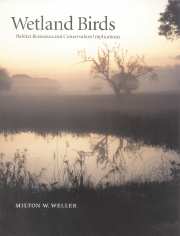Book contents
- Frontmatter
- Contents
- List of plates
- Preface
- Acknowledgments
- 1 Introduction
- 2 Wetlands: what, where, and why
- 3 Major groups of birds that use wetlands
- 4 Water and other resource influences
- 5 Foods, feeding tactics, strategies, and guilds
- 6 Bird mobility and wetland predictability
- 7 Other behavioral and physical influences on wetland living
- 8 Spatial and structural patterns
- 9 Habitat dynamics: water, plant succession, and time
- 10 Population consequences of wetland abundance and quality
- 11 How birds influence wetlands
- 12 Conservation implications
- 13 Measures of bird habitat use and quality
- 14 Current status and some conservation problems
- 15 Conservation and management strategies
- 16 Outlook
- 17 Epilogue
- Appendix 1 Scientific names of birds and bird groups
- Appendix 2 Scientific names of animals and animal groups other than birds
- Appendix 3 Scientific names of plants and plant groups
- Index of birds and bird groups
- Subject index
8 - Spatial and structural patterns
Published online by Cambridge University Press: 02 October 2009
- Frontmatter
- Contents
- List of plates
- Preface
- Acknowledgments
- 1 Introduction
- 2 Wetlands: what, where, and why
- 3 Major groups of birds that use wetlands
- 4 Water and other resource influences
- 5 Foods, feeding tactics, strategies, and guilds
- 6 Bird mobility and wetland predictability
- 7 Other behavioral and physical influences on wetland living
- 8 Spatial and structural patterns
- 9 Habitat dynamics: water, plant succession, and time
- 10 Population consequences of wetland abundance and quality
- 11 How birds influence wetlands
- 12 Conservation implications
- 13 Measures of bird habitat use and quality
- 14 Current status and some conservation problems
- 15 Conservation and management strategies
- 16 Outlook
- 17 Epilogue
- Appendix 1 Scientific names of birds and bird groups
- Appendix 2 Scientific names of animals and animal groups other than birds
- Appendix 3 Scientific names of plants and plant groups
- Index of birds and bird groups
- Subject index
Summary
Wetlands are especially known for their abundance of some species or groups of birds as well as for their diversity of species not found elsewhere. The major reason for this abundance presumably is the availability of resources produced by the great primary productivity of wetlands. The diversity of species undoubtedly is linked to diversity of resources produced in the many microhabitats resulting from water-depth gradients and fluctuations. The range of spatial scales we can examine was outlined above, but I would like here to focus on factors that influence bird use within and among wetlands. Although the emphasis is on geographical, and physical or structural patterns in wetlands, this includes structural aspects of live components such as plants (Table 8.1). Plants vary in life form or physical stature, which, with water distribution, creates visual patterns useful to us as indicators of wetland types and conspicuous to birds as indicators of various essential resources. We will first consider the range from homogeneity to heterogeneity that can exist in certain wetland types, forming within-wetland variation of habitats (microhabitats), and then consider larger-scale relationships among wetlands or wetland complexes or regimes, which can best be appreciated by first understanding the patterns found in individual wetlands.
Vegetation life form
Wetland types differ in the height, diameter, and robustness of dominant plants as well as in the range of plant species diversity, which with variation in water regimes can result in highly variable and sometime quite complex patterns of habitat diversity.
- Type
- Chapter
- Information
- Wetland BirdsHabitat Resources and Conservation Implications, pp. 121 - 144Publisher: Cambridge University PressPrint publication year: 1999



